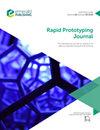Printed layers height calibration curve and porosity in laser melting deposition of Ti6Al4V combining experiments, mathematical modelling and deep neural network
IF 3.6
4区 工程技术
Q1 ENGINEERING, MECHANICAL
引用次数: 0
Abstract
Purpose Porosity is a commonly analyzed defect in the laser-based additive manufacturing processes owing to the enormous thermal gradient caused by repeated melting and solidification. Currently, the porosity estimation is limited to powder bed fusion. The porosity estimation needs to be explored in the laser melting deposition (LMD) process, particularly analytical models that provide cost- and time-effective solutions compared to finite element analysis. For this purpose, this study aims to formulate two mathematical models for deposited layer dimensions and corresponding porosity in the LMD process. Design/methodology/approach In this study, analytical models have been proposed. Initially, deposited layer dimensions, including layer height, width and depth, were calculated based on the operating parameters. These outputs were introduced in the second model to estimate the part porosity. The models were validated with experimental data for Ti6Al4V depositions on Ti6Al4V substrate. A calibration curve (CC) was also developed for Ti6Al4V material and characterized using X-ray computed tomography. The models were also validated with the experimental results adopted from literature. The validated models were linked with the deep neural network (DNN) for its training and testing using a total of 6,703 computations with 1,500 iterations. Here, laser power, laser scanning speed and powder feeding rate were selected inputs, whereas porosity was set as an output. Findings The computations indicate that owing to the simultaneous inclusion of powder particulates, the powder elements use a substantial percentage of the laser beam energy for their melting, resulting in laser beam energy attenuation and reducing thermal value at the substrate. The primary operating parameters are directly correlated with the number of layers and total height in CC. Through X-ray computed tomography analyses, the number of layers showed a straightforward correlation with mean sphericity, while a converse relation was identified with the number, mean volume and mean diameter of pores. DNN and analytical models showed 2%–3% and 7%–9% mean absolute deviations, respectively, compared to the experimental results. Originality/value This research provides a unique solution for LMD porosity estimation by linking the developed analytical computational models with artificial neural networking. The presented framework predicts the porosity in the LMD-ed parts efficiently.结合实验、数学建模和深度神经网络分析 Ti6Al4V 激光熔融沉积中的印刷层高度校准曲线和孔隙率
目的由于反复熔化和凝固造成的巨大热梯度,气孔是激光增材制造工艺中常见的缺陷。目前,孔隙率估算仅限于粉末床熔融。在激光熔融沉积(LMD)过程中,需要对孔隙率估算进行探索,特别是与有限元分析相比,分析模型能提供成本和时间效益高的解决方案。为此,本研究旨在为激光熔融沉积过程中的沉积层尺寸和相应的孔隙率制定两个数学模型。首先,根据操作参数计算沉积层尺寸,包括层高、宽度和深度。这些输出结果被引入第二个模型,以估算零件的孔隙率。这些模型与 Ti6Al4V 基底上 Ti6Al4V 沉积的实验数据进行了验证。还为 Ti6Al4V 材料开发了校准曲线 (CC),并使用 X 射线计算机断层扫描进行了表征。模型还与文献中采用的实验结果进行了验证。经过验证的模型与深度神经网络(DNN)相连接,通过 1,500 次迭代共 6,703 次计算对其进行训练和测试。计算结果表明,由于同时加入了粉末颗粒,粉末元素在熔化过程中消耗了很大比例的激光束能量,导致激光束能量衰减,降低了基底的热值。主要运行参数与 CC 的层数和总高度直接相关。通过 X 射线计算机断层扫描分析,层数与平均球度直接相关,而与孔的数量、平均体积和平均直径的关系则相反。与实验结果相比,DNN 和分析模型分别显示出 2%-3% 和 7%-9% 的平均绝对偏差。 原创性/价值 这项研究通过将开发的分析计算模型与人工神经网络联系起来,为 LMD 孔隙度估算提供了独特的解决方案。所提出的框架可有效预测 LMD 零件中的孔隙率。
本文章由计算机程序翻译,如有差异,请以英文原文为准。
求助全文
约1分钟内获得全文
求助全文
来源期刊

Rapid Prototyping Journal
工程技术-材料科学:综合
CiteScore
8.30
自引率
10.30%
发文量
137
审稿时长
4.6 months
期刊介绍:
Rapid Prototyping Journal concentrates on development in a manufacturing environment but covers applications in other areas, such as medicine and construction. All papers published in this field are scattered over a wide range of international publications, none of which actually specializes in this particular discipline, this journal is a vital resource for anyone involved in additive manufacturing. It draws together important refereed papers on all aspects of AM from distinguished sources all over the world, to give a truly international perspective on this dynamic and exciting area.
-Benchmarking – certification and qualification in AM-
Mass customisation in AM-
Design for AM-
Materials aspects-
Reviews of processes/applications-
CAD and other software aspects-
Enhancement of existing processes-
Integration with design process-
Management implications-
New AM processes-
Novel applications of AM parts-
AM for tooling-
Medical applications-
Reverse engineering in relation to AM-
Additive & Subtractive hybrid manufacturing-
Industrialisation
 求助内容:
求助内容: 应助结果提醒方式:
应助结果提醒方式:


